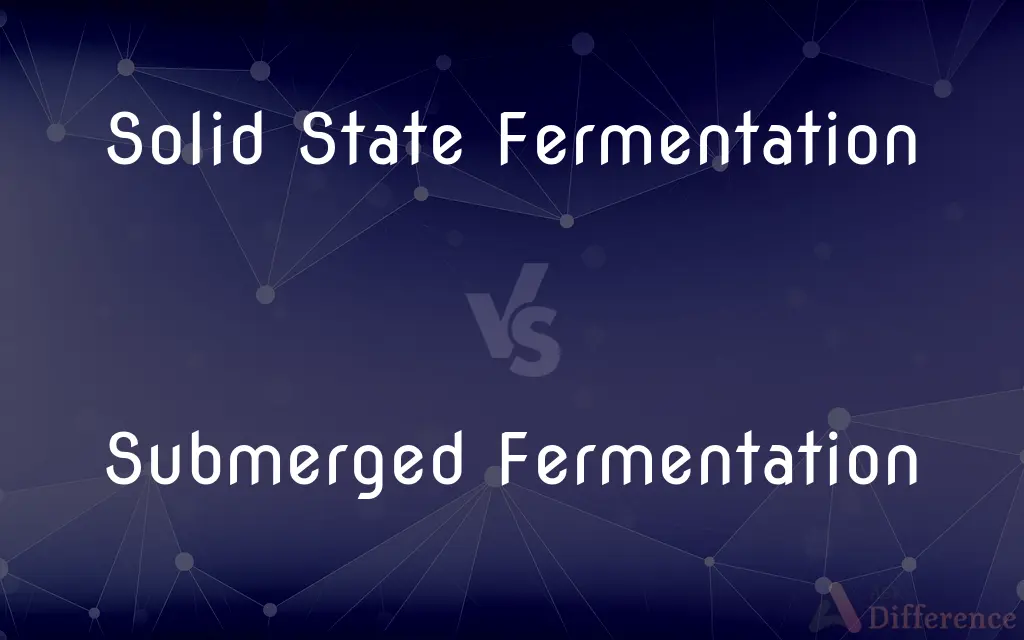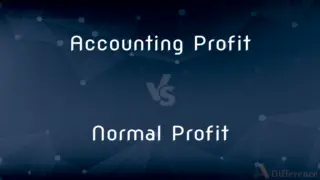Solid State Fermentation vs. Submerged Fermentation — What's the Difference?
By Tayyaba Rehman — Published on January 16, 2024
Solid state fermentation (SSF) involves microorganisms fermenting on a solid material without free water, while submerged fermentation (SmF) occurs in a liquid medium.

Difference Between Solid State Fermentation and Submerged Fermentation
Table of Contents
ADVERTISEMENT
Key Differences
Solid State Fermentation (SSF) is a process where microorganisms grow on a solid substrate without the presence of free water. This method is akin to natural fermentation processes and is often used for products like enzymes, organic acids, and fermented foods. Submerged Fermentation (SmF), however, involves the cultivation of microorganisms in a liquid nutrient medium, where the substrate is dissolved or suspended in water.
In SSF, the solid substrate not only provides nutrients but also acts as a physical support for the growth of microorganisms. This method is efficient in terms of energy and water usage and often results in higher product concentrations. SmF allows for easier control and monitoring of the fermentation process, including parameters like pH, temperature, and oxygen levels, making it suitable for large-scale production.
SSF is typically used for the production of products like antibiotics, citric acid, and traditional fermented foods such as tempeh and soy sauce. It is favored for its lower risk of contamination and lower energy requirements. SmF is widely used in the pharmaceutical industry for the production of antibiotics, vaccines, and for wastewater treatment, due to its scalability and ease of product recovery.
The control of environmental conditions in SSF can be challenging due to the heterogeneity of the solid substrate. In contrast, SmF offers better control over fermentation conditions, making it more predictable and consistent. However, SmF typically requires more energy, especially for aeration and agitation, compared to SSF.
From an environmental standpoint, SSF is considered more sustainable, producing less wastewater and utilizing agricultural residues effectively. SmF, while requiring more resources, is more adaptable to a variety of industrial applications due to its ease of scaling and process control.
ADVERTISEMENT
Comparison Chart
Medium
Solid substrate without free water
Liquid nutrient medium
Typical Uses
Enzymes, fermented foods, organic acids
Pharmaceuticals, wastewater treatment
Process Control
Less control, heterogeneous environment
More control, homogeneous environment
Energy Efficiency
Generally more energy-efficient
Requires more energy for aeration and agitation
Scalability
Limited scalability
Highly scalable for industrial applications
Compare with Definitions
Solid State Fermentation
Limited process control
Controlling conditions in SSF can be more challenging.
Submerged Fermentation
Fermentation in liquid
Antibiotics are commonly produced using SmF.
Solid State Fermentation
Energy-efficient
SSF is preferred for its energy efficiency in enzyme production.
Submerged Fermentation
Scalable for industrial use
SmF is widely used in large-scale industrial applications.
Solid State Fermentation
Low water usage
SSF is advantageous for its minimal water requirement.
Submerged Fermentation
High resource requirement
SmF requires significant energy for maintaining optimal conditions.
Solid State Fermentation
Utilizes agricultural residues
SSF often uses agricultural by-products as substrates.
Submerged Fermentation
Controlled fermentation environment
SmF allows precise control over fermentation conditions.
Solid State Fermentation
Fermentation on solids
SSF is used for producing traditional tempeh.
Submerged Fermentation
Suitable for pharmaceuticals
Vaccine production is often done through SmF.
Common Curiosities
What are common products of SSF?
Enzymes, organic acids, and traditional fermented foods.
Can SSF use agricultural waste?
Yes, it's effective in utilizing agricultural residues.
Does SSF require less water?
Yes, it operates with minimal free water.
How is oxygen supplied in SmF?
Through aeration and agitation in the liquid medium.
Is SmF used in beer production?
Yes, SmF is commonly used in brewing beer.
Is SmF suitable for large-scale production?
Yes, due to its scalability and control.
Can SmF be automated?
Yes, it's easier to automate and control compared to SSF.
What's a limitation of SSF?
It has limited scalability and less process control.
Is SmF more resource-intensive?
Yes, particularly in terms of energy and water usage.
Are SSF processes energy-efficient?
Generally, they are more energy-efficient than SmF.
Is SmF more predictable than SSF?
Yes, due to better control over fermentation conditions.
Does SSF have a lower risk of contamination?
Yes, due to less water content, reducing the risk of microbial contamination.
Can SSF be used for biofuel production?
Yes, it's being explored for biofuel production.
What makes SSF environmentally friendly?
Its lower water and energy usage and use of waste materials.
Can SmF be used for waste treatment?
Yes, it's effective in wastewater treatment processes.
Share Your Discovery

Previous Comparison
Hindu Dharma vs. Sanatana Dharma
Next Comparison
Red Wine Vinegar vs. White Wine VinegarAuthor Spotlight
Written by
Tayyaba RehmanTayyaba Rehman is a distinguished writer, currently serving as a primary contributor to askdifference.com. As a researcher in semantics and etymology, Tayyaba's passion for the complexity of languages and their distinctions has found a perfect home on the platform. Tayyaba delves into the intricacies of language, distinguishing between commonly confused words and phrases, thereby providing clarity for readers worldwide.















































